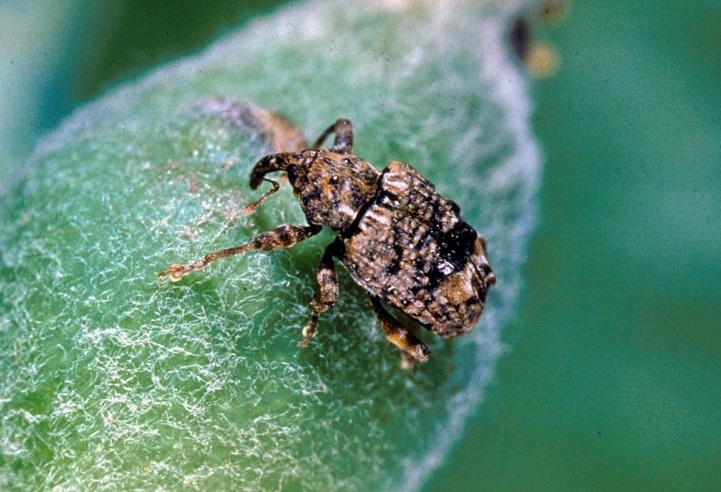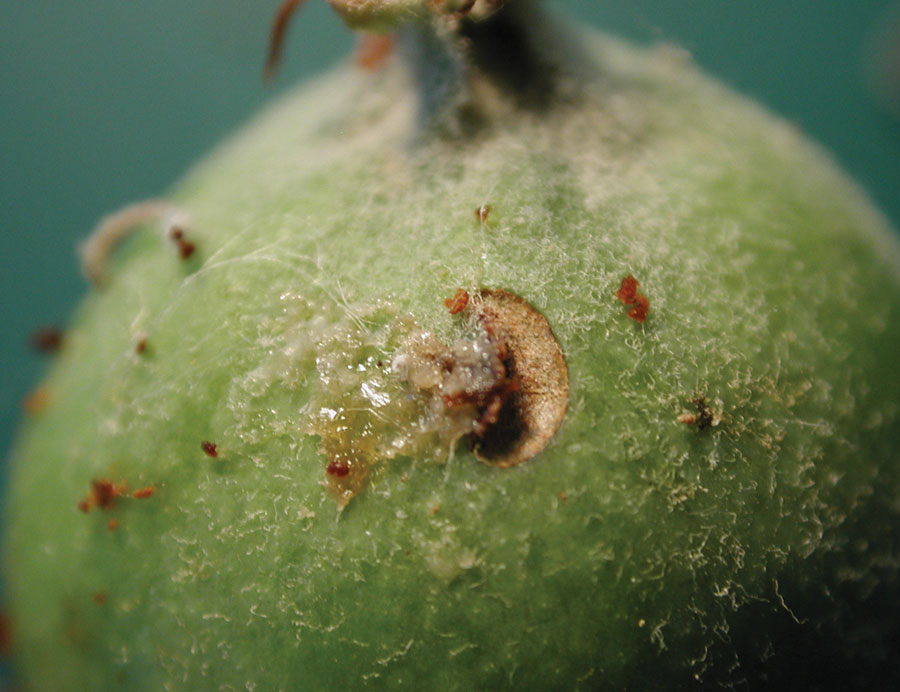When spring weather begins to warm with abundant damp showers, the plum curculio (Conotrachelus nenuphar) sets its sight on plum, apple, peach, apricot, cherry and other pome and orchard stone fruits, under whose skin this true weevil lays its eggs. Causing considerable damage to fruit, the curculio lays eggs under a flap of flesh – leaving bumps or crescent shaped scars visible to the eye. Burrowed-through fruits fall to the ground decayed while scarred fruits show the mark of preliminary laying and feeding.

Life Cycle and Laying
Native to North America, plum curculios are weevils or snout beetles that overwinter in ground litter, hedgegrows, or the soil and become active again in spring – coinciding with the time of apple tree blossoming. Dark brown or steel gray in color, adults bear four pairs of ridges covering their wings and a rough snout colored with black, gray or brown specks. They emerge as adults during a period of 4-6 weeks in the spring (though 40-60% of emergence occurs in a single day).
After emergence, they feed on tree buds, flowers, and new-set fruit – mate – and then lay tiny oval eggs in crescent-shaped cuts on fruit where they will mature and hatch in 2-12 days. Larvae are 6-9 mm long, grayish-white, legless grub with brown heads that bore into the fruit during a period of 2-3 weeks. After burrowed fruit falls, fully grown larvae pupate in the soil in a period of 12-16 days, where they will hibernate in the soil for overwintering.

Controlling Curculio
While plum curculio can seriously affect orchard fruit, organic and home growers have several options for controlling this pest. Successful management requires careful observation of trees and applications of several treatments throughout the year to keep growing trees healthy, along with proper fertilizing, mulching, and watering, so that they may better resist infestation. The Natural Gardener recommends the following protocol: http://www.nhpnetwork.org/uploads/1/9/2/6/1926681/plum_curculio.pdf
EARLY SPRING:
- During early spring, when adults emerge from their overwintering stage and begin to feed on newly set fruit and leaves and flowers, lay sheets on the ground beneath trees and shake them vigorously to knock plum curculios to the ground. Submerge the sheets in hot soapy water to kill them. Perform this task twice a day during their 2-3 week spring active season.
- Apply Kaolin Clay or an organic insecticide such as Pyrethrin or EcoSmart Insect Killer to the tree canopy in the early morning or late evening.
- Timing is important! DO NOT SPRAY DURING FULL BLOOM or when bees are present! Choose, AT PETAL FALL – when 75% of the flowers have fallen (5 days after bloom) and/or AT SHUCK SPLIT: when fruit’s papery covering or calyx has split (14 days after bloom).
SPRING/SUMMER:
- Gather and destroy all fallen fruit every other day to prevent larvae from tunneling into the ground in their earthen cells 1-3 inches below the soil surface, where they will pupate and form a new generation of adults in 3-4 weeks. Running chickens through your orchard is also a fantastic way to deal with fallen fruit and larvae.
- A second generation of plum curculios usually emerges in late July through late October. Keep an eye out for crescent shaped scars on fruit and employ the shaking method and/or organic sprays to reduce populations.
FALL:
- Spray Beneficial Nematodes to help control larvae in the soil, and clean debris from around the trees (in grass, fallen fruit, leaves) to reduce overwintering sites for the curculio.
For more information:
https://en.wikipedia.org/wiki/Plum_curculio
http://nysipm.cornell.edu/factsheets/treefruit/pests/pc/pc.asp
http://www.nhpnetwork.org/uploads/1/9/2/6/1926681/plum_curculio.pdf
http://www2.ca.uky.edu/entomology/entfacts/ef202.asp
Purchase nematodes for plum curculio control:
https://www.arbico-organics.com/product/nemattack-beneficial-nematodes-sf-steinernema-feltiae
https://www.evergreengrowers.com/nemasys-steinernema-feltiae-group-nema.html
This edition of POP TIPS prepared with assistance from Alyssa Schimmel.
SUPPORT US! If you found this entry useful, informative, or inspiring, please consider a donation of any size to help POP in planting and supporting community orchards in Philadelphia: phillyorchards.org/donate.